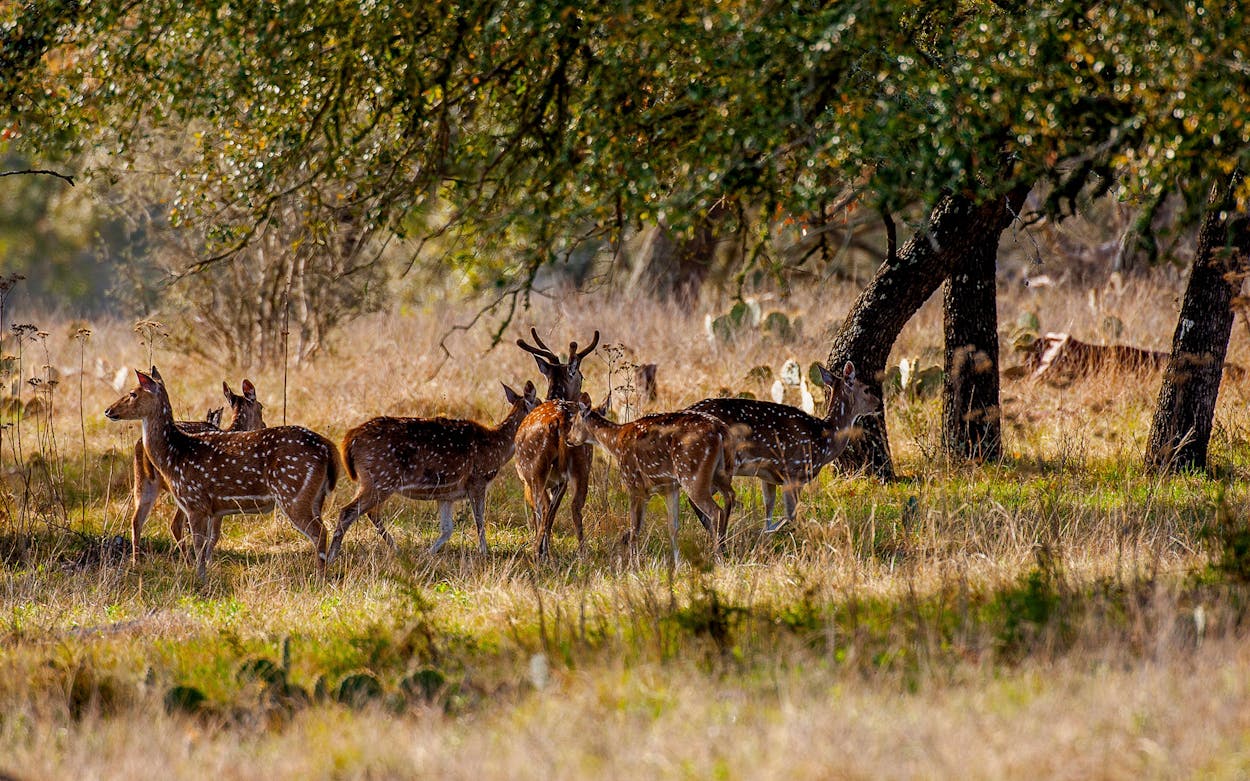The spotted fawn was leaning against the screen door of Daniel Oppenheimer’s back porch near Luckenbach. Oppenheimer found it when he ventured outside on the first morning of last week’s record freeze. The fawn had died in the night.
Oppenheimer’s power, water, and Internet would not be restored for several days. With little else to do, he wandered the land with his dog. He counted thirteen more deer that week. They died under Ashe juniper trees, in a barn, under a carport, in wide-open fields. All were axis, a white-spotted deer species native to the Indian subcontinent. “It was awful watching these animals fall apart over several days,” said Oppenheimer, who works for the Hill Country Alliance, a conservation group.
Introduced to Texas about eighty years ago, axis deer do not handle freezing temperatures well. Neither do many of the exotic antelope, bovines, and other kinds of deer that roam swaths of Texas, the epicenter of the nation’s exotic game industry. The state is home to approximately 130 species of so-called Texotics, with hunters paying thousands of dollars for the opportunity to shoot trophy bucks and bulls whose lineages are typically traced to the hot climates of Africa and Asia.
Winter Storm Uri devastated the industry. Charly Seale, the Exotic Wildlife Association president, told the Washington Post that his Hill Country ranch alone lost more than $2 million in animals, including 85 axis deer, during the storm. “It’s an extremely trying time for all of us,” he told the newspaper.
Axis deer are probably the most common exotic species that have escaped from private ranches and are now found throughout the Hill Country. Matthew Buchholz, a Texas Tech doctoral student who researches the deer, said axis suffered from the freeze throughout their range but primarily in open grasslands where they couldn’t bed down in thick cover. The timing was particularly bad for axis. About 70 percent of the species reproduce in February, so the cold snap hit when they were at their most vulnerable. Most of the axis carcasses belonged to newborn fawns and pregnant does. The deer were reduced to skin and bone.
“There was no fat on any of them we sampled,” said Roy Leslie, a Hill Country rancher who volunteered to examine the dead axis at Oppenheimer’s place near Luckenbach. “It was brutal,” Leslie said. “No matter how much you don’t like to see exotics, nothing should die that way.”
Some of the stomachs of the dead axis were filled with undigested plant material. To Leslie, it looked and smelled like yard clippings. Their fecal samples were also largely undigested, leading Buchholz to speculate that hypothermia could have rendered the deer unable to digest plants by changing the temperature of bacteria in their guts.
Leslie (who has described himself as a sworn enemy of free-ranging exotic deer), Oppenheimer, and Buchholz are participants in the Hill Country Alliance’s Axis Deer Control Project, which launched earlier this month to address the ever-increasing population of axis. The species has been blamed for overbrowsing the Hill Country, out-competing native whitetail deer for food, and causing erosion that damages rivers and creeks.
Buchholz couldn’t estimate the percentage of axis deer that died in the freeze. He declined to say whether he considers the sudden die-off of nonnative axis deer a positive outcome, giving the land a chance to heal. “Given their ability to bounce back and reproduce, I don’t know how this will affect axis long-term,” he said. “They could bounce back pretty quickly.”
Axis are notably wily creatures and are less likely to visit game feeders and watering stations than native whitetails. During the week that Oppenheimer was snowed in, however, a large axis buck spent several days under his carport and also in a pump house where he was drinking from water pipes that had burst. “We’ve got way too many free-ranging axis in the Hill Country,” Oppenheimer said, “but watching this buck deteriorate over several days was gruesome.”
The one positive, he noted, was that researchers had a rare opportunity to study animals that have lived among us for many decades but are usually so elusive. “There’s still so much we don’t know about them,” he said.
- More About:
- Hunting & Fishing
- Critters
- Winter Storm 2021








